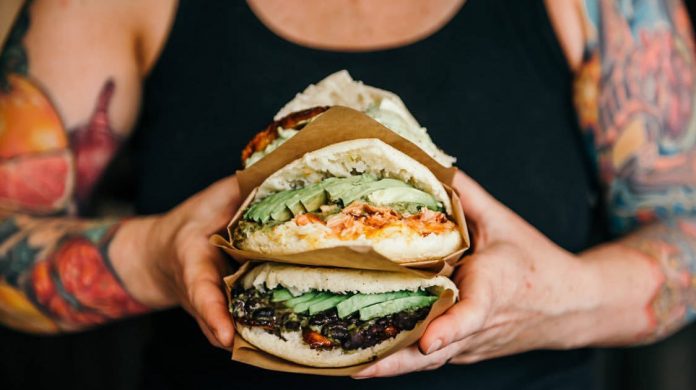London now boasts an incredible array of award-winning restaurants and critically acclaimed chefs. So it’s time to get rid of those fish-and-chips stereotypes for good.
No Londoner in the 1980s would have dared describe the city as a global gourmet destination—and I know, because I was there. There were occasional bright spots—fine-dining icons like the still-open Le Gavroche, for example—but ordinary Brits would rarely have ventured past its green baize-lined doors. No, 1980s London was a city of Berni Inn steakhouses or fish n’ chip shops doling out the same mushy peas they’d served for ages.
Three decades later, though, and it’s virtually unrecognizable: London is arguably one of the world’s most influential restaurant cities, home to a slew of boldfaced name chefs who are redefining food. There’s Noma alum Tom Sellers, owner of Story, and Isaac McHale of The Clove Cub, and Ollie Dabbous, for whose four-year old namesake restaurant tables are booked four months in advance (Any cancelations are filled with a modern twist—via its Twitter feed.) But how did London’s dining scene transform so drastically in less than 30 years?
According to Peter Harden, co-founder of the Zagat-like restaurant guide, Harden’s, the turning point came in 1992 with the opening of an unlikely pair of restaurants: Planet Hollywood London and Quaglino’s. Harden says the former, brainchild of Hard Rock veteran Robert Earl, “added to the ready-to-roll snowball which was the democratization of eating out.” Its media-friendly opening, attended by Sylvester Stallone, Arnold Schwarzenegger, and Bruce Willis, shattered conventional parameters that defined a London dining venue and encouraged more ordinary Brits to splurge on eating out—albeit on overpriced burgers.
Even more crucial, per Harden, was the opening of Quaglino’s—or rather, the re-opening, as the historic Art Deco restaurant underwent a radical makeover under the auspices of erstwhile interiors design guru Terence Conran (and was even name-checked in Ab Fab). Conran’s emphasis on effortless service, abundance—bottomless bread baskets were a trademark—and unabashed glamour not only defined the modern London restaurant but also turned Quaglino’s Q-shaped ashtrays into the favorite, ahem, keepsake of 1990s London. Together, this unlikely pair of restaurants created a template for media-friendly, approachable, and delicious meals that has been followed by most of London’s top chefs ever since.
Harden points to other factors that changed the dining scene in London during the 1990s. The driving impetus behind British chefs’ rediscovery of local produce from the likes of Daylesford Farms was the “mad cow disease” scares that filled the front pages in early 1990s. “That scare drove people to question the quality of the food they were being given, and gave anyone who had, say, an organic story more of a leg up,” Harden says. What’s more, the uptick in upscale yet unstuffy restaurants coincided handily with the increased disposable income among young Brits. Like many in the developed world, they increasingly delayed childbirth, so professional 20-somethings were more willing and able to splurge on dinners rather than diapers. There were more of them, too: though London’s boundaries remain unchanged since the 1980s, its population since then has ballooned from 6.8 million in the mid 1980s to 8.6 million, a rise of almost one third and a record high. Those extra Londoners, of course, are a captive market for food world entrepreneurs hungry to make their names as celebrity chefs.
A Day in London
Television’s growing obsession with cooking shows was crucial, too: much as in the U.S., the last two decades have seen them dominate the British airwaves (The Great British Bake Off, anyone?) Harden remembers constant calls on his office phone at the end of the 1990s. “We started to get calls from so many production companies asking us ‘Do you know any chefs that look good on telly? It doesn’t matter if they can cook’,” he laughs. The primetime presence of Jamie Oliver, Gordon Ramsay, and company added a starry sparkle that made Brits more interested than ever before in eating out. No longer was food criticism the purview of tweed-jacketed oddballs like Mystic Pizza’s Fireside Gourmet, either; instead, it became a lingua franca among the urban and educated here much the same time as it did in the U.S. “Foodie one-upmanship began to become a social currency,” Harden explains, suggesting it replaced conventional, class-based competition. “Instead of ‘My country house is bigger than yours’ it was ‘I know the difference between burrata and mozzarella better than you do.’
The Best Little Restaurant in London
The new breed of chefs has also helped put the social in social media. Millennial kitchen sergeants such as Dabbous or Isaac McHale are today allies, even friends, rather than rivals. It’s a stark contrast to the early days of cool Britannia cuisine, when Gordon Ramsay notoriously spiked his onetime mentor Marco Pierre White’s business by stealing the reservations book from his restaurant in the late 1990s. These chummy cooks recognize the power of working together, rather than against each other, to raise the profile of both British cooking and London’s dining scene on a wider world stage.
Most recently, there’s been another unexpected boost to the dining scene in London, says Jeremy Wayne, long-time restaurant critic of Tatler magazine, and host of its annual Restaurant Awards. The London Olympics in 2012 were intended to help regenerate Stratford and its environs. They helped this run-down, somewhat industrial corner of the city loosen the stranglehold of West End-based chefs and so encouraged more experimentation. “That’s when the fulcrum of restaurants shifted completely east—if I get ten emails a day about new restaurants now, nine of them will be there,” Wayne says. East London, of course, is home to some of the capital’s kookier new cafes—the breakfast-all-day Cereal Killer, for example.
In today’s London, with celebrity chef-driven restaurants opening almost-weekly, Peter Harden believes that “eating out is the new rock n’roll.” And it’s all thanks to Arnie, Sly, and some very souvenir-worthy ashtrays.




























